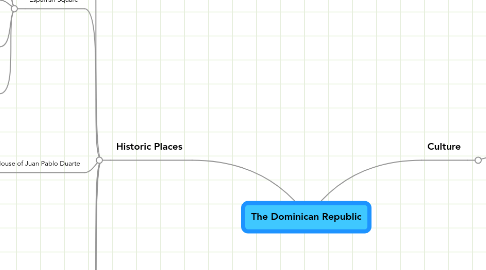
1. Historic Places
1.1. The Sundial
1.1.1. built in 1753 by Governor Francisco Rubio y Peñaranda
1.1.2. It was positioned so that officials of the Royal Houses could see the time just by glancing outside their windows.
1.1.3. On the southeast side you can see the time before noon, on the southwest side the time in the afternoon.
1.1.4. remodeled for the celebration of the 500th anniversary of Columbus’s arrival in the Americas.
1.2. Espanish Square
1.2.1. eastern side of the colonial zone
1.2.2. statue of Nicolas de Ovando, founder of Santo Domingo, stands there because of his accomplishments
1.2.3. The square is surrounded by exquisite colonial houses and restaurants
1.2.4. At night, it is beautifully lit and brushed by tropical breezes blowing off the river and sea, surrounding you with the best possible Dominican ambiance
1.2.5. It is at this square that you find a plaque saying that UNESCO declared the colonial zone of Santo Domingo a World Cultural Heritage Site
1.3. House of Juan Pablo Duarte
1.3.1. He was the father of the Dominican Republic, it was not known if he was born in the house but he definitly lived there.
1.3.2. In the 19th century it was restored
1.3.3. now it a museum dedicated to the life of Juan Pablo Duarte
1.3.4. Busts of the members of “la Trinitaria,” a secret pro-independence organization, are exhibited in the patio
1.4. Convent of the Dominicans
1.4.1. The Dominican Church dates from approximately 1510
1.4.2. Fray Antonio de Montesinos, the first person in the New World to speak out against the Spaniards’ abuse of the Indians, lived and preached here.
1.4.3. his statue is at the mouth of the Ozama River where it meets the Caribbean
1.4.4. Bartolomé de las Casas came to take Holy Orders in 1515.
1.4.5. In 1538 the first university in the New World, dedicated to St. Thomas Aquino, was founded here; though the building no longer survives, the university lives on as the Universidad Autónoma de Santo Domingo.
1.4.6. Inside the church is the astounding Chapel of the Rosary, with the sun and signs of the Zodiac carved into the stone of its vaulted ceiling.
1.5. Church of San Miguel
1.6. Church Convent of las Mercedez
1.7. Pueta del Conde
2. Culture
2.1. The Dominican Carnival
2.1.1. Celebrated every weekend of February through the beggining of March
2.1.2. Most colorful of all traditions, includes dancing in the city streets
2.1.3. People wear costumes
2.1.3.1. Most common is called the diablo cojuelo, it is a suit of many colorful layers, small mirrors, and bells. People will wear it with a devils mask
2.1.4. Carnival has been around since the 16th century but became very popular on February 27, 1844 the day The Dominican Republic gained its independance
